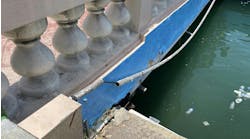Note: This article references the 2017 NEC because the Philadelphia area is still operating under that version of the Code.
As you advance your electrical career, you must understand how everything works in the building and construction process. My advice for all apprentices is to empower yourself with all of the information you can to help yourself grow, move vertically, and impress the boss. Basically, this means don’t be one-dimensional!
In the process of mastering your new craft, pay attention to all parties involved in conceiving, managing, and administering the project you're working on. It's essential to understand the role everyone plays behind the scenes from beginning to end. This includes the permitting and plans approval process at the township’s electrical department and the final electrical inspection at the end. Informative Annex H provides a bird’s-eye view into how an electrical department is built, structured, and managed.
Instruction guide for the township
Article 90, located at the beginning of the Code book, covers the introduction of the National Electrical Code (NEC). Article 80 Informative Annex H provides requirements for the administration and enforcement of the NEC — it's the prelude to Art. 90. Neatly tucked at the back of the Code, it’s not part of the "requirements" of the NEC. Instead, it’s included for "informational purposes only" and must be specifically adopted by the local jurisdiction. Knowing this helps us understand why different jurisdictions or towns use different versions of the Code and enforce different guidelines within it; they are free to use whatever version and rules they deem fit. Therefore, it’s important to be adept in various versions of the Code because the rules may change from town to town in some states.
The Scope of Art. 80 provides instructions for:
- Inspection of installations as covered by Sec. 90.2.
- Investigation of fires caused by electrical installations.
- Review of construction plans, drawings, and specifications for electrical systems.
- Design, alteration, modification, construction, maintenance, and testing of electrical systems and equipment.
- Regulation and control of electrical installations at special events, including, but not limited to, exhibits, trade shows, amusement parks, and other similar special occupancies.
Application and purpose of Annex H
When the NEC is adopted in a jurisdiction or town, it can be applied to a new or existing building installation with construction permits issued after adopting the Code. Existing electrical installations that do not comply with guidelines of the "new" Code being enforced are usually permitted to be continued "in use," unless the authority having jurisdiction (AHJ) determines that there is too much "lack of conformity" with the newly adopted NEC.
If an electrical installation in a structure or building presents an "imminent danger" to occupants, changes may be required to correct hazards; Annex H lays out the step-by-step process for the township or municipality to follow in enforcing the newly adopted Code. The AHJ can provide existing "occupied" building owners a remedy "to remain in use" and a reasonable amount of time for compliance with the new Code or just specific parts, depending on the degree of the hazard. Here are a few of the conditions required:
- The occupancy classification remains unchanged.
- No condition exists that is deemed hazardous to life or property and constitutes an imminent danger.
Explanation of enforcement and authority
Per Sec. 80.13, always remember that AHJs or approval agencies "may vary, as do their responsibilities." [Informational Note for the Definition AHJ] "The authority having jurisdiction may be a federal, state, local, or other regional department or individual such as a fire chief, fire marshal, chief of a fire prevention bureau, labor department, or health department; building official; third-party electrical inspector or others having statutory authority.
"For insurance purposes, an insurance inspection department, rating bureau, or other insurance company representative may be the authority having jurisdiction. In many circumstances, the property owner or his or her designated agent assumes the role of the authority having jurisdiction; at government installations, the commanding officer or departmental official may be the authority having jurisdiction."
The AHJ has power to police
As you can see, "individuals that can be designated" or empowered by the governing body or township to enforce the electrical code are extensive. They can render or request "necessary assistance" in enforcing the electrical Code — in other words, they can request assistance from other agencies, delegate or empower other agencies, and request enforcement assistance from police, fire, and other qualified individuals, such as private third-party electrical inspectors.
Setting up the Electrical Board
Annex H (80.13) also provides the AHJ with instructions on setting up the Electrical Board and Board Members, which are appointed by the governor with the advice and consent of the Senate. In smaller jurisdictions, appointments can be performed by the mayor with the advice and consent of the Council (or equivalent). Newly elected Board Members shall have voting powers that should reflect a balanced representation of at least five individuals or organizations, such as:
- Chief electrical inspector from a local government (for State Board only).
- An electrical contractor operating in the jurisdiction (remember, make friends wherever you go).
- A licensed professional engineer engaged primarily in designing or maintaining electrical installations.
- A journeyman electrician (this is an opportunity for you later on in your career).
Instructions for large or small townships
Annex 80 also provides instructions to the AHJ for electing and empowering additional types of board members based on the size, structure, and resources available in the jurisdictional area or town. They have the power to elect:
- A master (supervising) electrician.
- The fire marshal (or fire chief).
- A representative of the property/casualty insurance industry.
- A representative of an electric power utility operating in the jurisdiction.
- A representative of electrical manufacturers primarily and actively engaged in producing materials, fittings, devices, appliances, luminaires, or apparatus used as part of or in connection with electrical installations.
- A member of the labor organization that represents the primary electrical workforce.
- A public member who is not affiliated with any other designated group.
- A representative of a telecommunications utility operating in the jurisdiction.
Electrical Board Duties set by Annex 80.15 (F)
Here are a few of the many duties that the newly formed Electrical Board must perform after its creation:
- Adopt the necessary rules and regulations to administer and enforce Art. 80.
- Establish qualifications for electrical inspectors.
- Revoke or suspend the recognition of any inspector's certificate for the jurisdiction.
The newly formed Electrical Board must provide advance notice for a public hearing for residents impacted by adopting the new electrical code. The Board is also authorized to establish and update (when necessary) "the provisions for the safety of electrical installations to conform to the current edition of the National Electrical Code (NFPA 70) and other nationally recognized safety standards for electrical installations."
As you can see, the Code provides guidelines for electrical installations and instructions for building an entire electrical board/unit/department. A lot goes into constructing a municipal building department, issuing permits, and managing construction projects. These are your tax dollars at work — these processes facilitate the progression of construction. Never take these functions for granted as you begin to navigate the landscape around you every day in the electrical trade. For more information on electrical inspectors or foremen, check out one of my previous articles on “Mastering the Chain of Command on Construction Job Sites — Part 5.”
Follow my column for more tips on applying electric basics concepts in the field, navigating the NEC, preparing for exams, and understanding how to apply Code guidelines in the field. Past columns include Everyday Instructions for Electricians, The Apprentices Guide to Special Equipment, The Apprentice’s Intro Guide to Motors, The Apprentice’s Guide to Service Entrance Cable, The Apprentice’s Guide to NEC Art. 382, The Apprentice’s Guide to Article 625, The Apprentice’s Guide to NEC Art. 550 , The Apprentice’s Guide to Informative Annex C, and The Apprentice’s Guide to Success in the Electrical Construction Industry. For more information on why a structured approach is so important to navigating the NEC and how to put its requirements into practice in real-world settings, read “The NEC for Newbies.”




